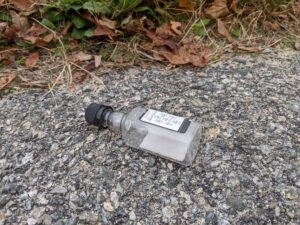 HYANNIS – Making the switch to a reusable water bottle might make you feel great in an environmentally conscious kind of way but, if you’re not careful, it can also make you sick.
HYANNIS – Making the switch to a reusable water bottle might make you feel great in an environmentally conscious kind of way but, if you’re not careful, it can also make you sick.
Here are some facts that will likely scare you straight into cleaning your container.
Studies have shown that water bottles that go uncleaned for one week contain 300,000 bacteria cells per square centimeter. That’s more bacteria than in a dog’s water bowl, according to a recent article in USA Today. Anyone like the idea of drinking from that?
Because of this build-up of bacteria, it’s important to remember a fact that some people tend to forget; reusable bottles must be thoroughly cleaned after every usage. Just as you wouldn’t keep using your coffee cup or silverware without cleaning them, you shouldn’t just keep refilling that water bottle.
“People don’t always think that way about reusable water bottles, and they may refill them over and over without cleaning them,” said Kathleen Kohut, director of infection prevention at Cape Cod Healthcare. “But that can lead to a lot of contamination. Even if it’s sterile water, it becomes contaminated when your mouth organisms mix with the water.
“Maybe you’re exercising, sweating, touching all sorts of things at the gym. Those germs can remain on the bottle for a day, a week, a month. You really need to clean it after every use,” she said.
Bacteria, fungi and even mold can thrive in a water bottle, thanks mainly to its moist environment. Simply rinsing the bottle out with water isn’t sufficient, and care must be taken when cleaning bottles that have attached straws and narrow-mouth lids with lots of nooks and crannies.
Tips for Cleaning
Cleaning can be quick and easy. Here are some methods to try:
• Wash with soap and water. Use a bottle brush to reach all those nooks and crannies and a pipe cleaner for the attached straw.
• Use vinegar, hydrogen peroxide, baking soda, dental cleaning tablets or even an antibacterial mouthwash. If using denture tablets, drop a tablet into a bottle filled with water, let it stand for 30 minutes and rinse out.
• Fill your bottle with water and add one or two tablespoons of white vinegar. Let it sit overnight. Make sure you close the bottle and shake it before leaving it to soak for the night. If you’re worried about the smell of vinegar, use baking soda and water.
• Add a small amount of hydrogen peroxide to kill mold. This method is also ideal if your bottle is slimy or has an odor. Just clean the bottle with soap and water and rinse with hot water. Pour about one-quarter cup of hydrogen peroxide into the bottle, close the lid tightly and vigorously shake the bottle. Pour out the hydrogen peroxide and rinse the bottle a final time. The bottle will be like new.
• Use bleach. Kohut recommends a 9-to-1 ratio of water to bleach, and then use a brush to lift film and dirt off the bottle. “Bacteria will adhere to the surface, so you need some friction,” said Kohut. Bleach will provide a truly deep cleaning, but be sure to rinse it out with clean water afterwards to remove any remnants of the bleach. It’s also best to avoid and abrasive scrubber when cleaning a stainless steel water bottle, which could scratch the exterior.
Finally, it’s best to air dry the water bottle so that no tiny droplets of water remain in the bottom, where bacteria could grow.
Clean those reusable water bottles regularly and you’ll be protecting your health, while helping to do the same for the environment.
























